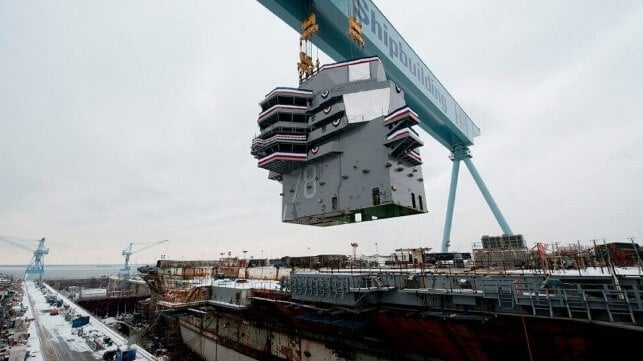Workers at Newport News Made Faulty Welds on U.S. Navy Carriers and Subs

Members of Congress are looking for answers after reports that workers at HII Newport News intentionally made faulty welds on U.S. Navy submarines and aircraft carriers.
After reviewing internal reporting, the company discovered that some of its workers were not using the right techniques to weld joints, and it investigated and self-reported the problem to the Department of Justice and the U.S. Navy.
“HII’s Newport News Shipbuilding is committed to building the highest-quality aircraft carriers and submarines for the U.S. Navy. We do not tolerate any conduct that compromises our company’s values and our mission of delivering ships that safeguard our nation and its sailors," HII told USNI, which first reported the deviation. "Based on our initial investigation, there is no indication of malicious intent."
In a statement, the Navy said that it puts top priority on the safety of vessels and sailors, and it said that it is investigating the full scope of the weld issue.
HII Newport News builds the Navy's new Ford-class aircraft carrier, as well as blocks for the Virginia-class and Columbia-class submarine programs. The effort to determine the extent of the impact on in-service vessels is still ongoing, and Congress wants a full report as soon as possible. On Friday, House Armed Services Committee leaders Rep. Mike Rogers (R-AL) and Rep. Adam Smith (D-WA) said that the Pentagon "needs to immediately provide our committee with answers and a plan for how they will protect U.S. Navy vessels against tampering."
Cost hikes and schedule slip continue for Columbia-class program
The news of faulty welding is the latest in a string of setbacks for U.S. Navy shipbuilding, and the list continued to lengthen on Monday with a new report from the Government Accountability Office (GAO). The agency confirmed that the Navy is struggling to contain cost growth and keep to schedule on the $130 billion Columbia-class program. These next-generation ballistic missile submarines are the service's top acquisition priority: When the current Ohio-class "boomers" retire next decade, the U.S. will need a new, permanent at-sea nuclear deterrent.
Despite the $2.6 billion-plus spent on reinforcing the submarine supplier base, the schedule continues to slip because of late materials. GAO reports that the Navy does not have a way to measure return on investment on the money it is spending on improvements to subcontractors' facilities and workforce programs - nor does it have a quality assurance program in place to fully oversee the work at so many new locations.
"Although Electric Boat and the program have ongoing efforts intended to help recover from persistent challenges, the lead submarine is entering a period of construction that involves additional risks that are likely to contribute to cost and schedule growth," cautioned GAO. "Our independent analysis calculated likely cost overruns that are more than six times higher than Electric Boat’s estimates and almost five times more than the Navy’s. As a result, the government could be responsible for hundreds of millions of dollars in additional construction costs for the lead submarine."
